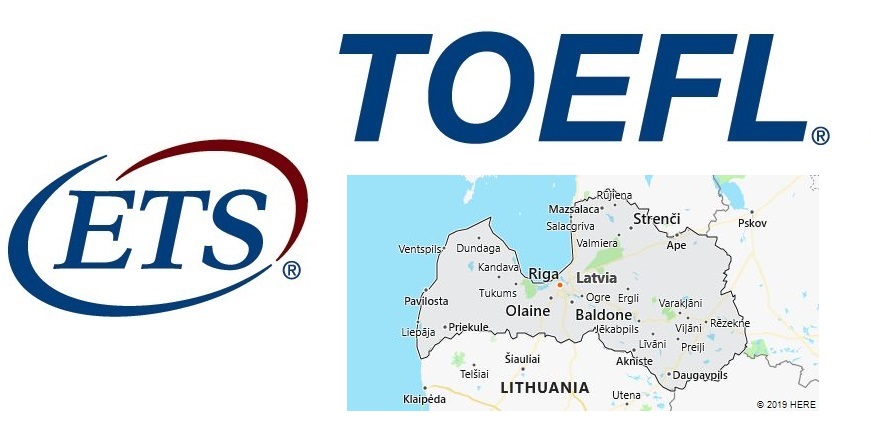The TOEFL iBT test is offered in this location.
The list below shows testing regions, fees and dates as of February 15, 2019, but availability may change when you register. Fees are shown in US$ and are subject to change without notice.
| Region | Testing Format | Fee | Test Dates |
|---|---|---|---|
| Riga | TOEFL iBT | $220 $220 $220 $220 $220 $220 $220 $220 $220 $220 $220 $220 $220 $220 $220 |
Sat., Feb 16, 2019 Fri., Mar 08, 2019 Sat., Mar 30, 2019 Fri., Apr 05, 2019 Sat., Apr 13, 2019 Fri., May 10, 2019 Sat., May 11, 2019 Sat., May 18, 2019 Sat., Jun 01, 2019 Fri., Jun 14, 2019 Sat., Jun 15, 2019 Sat., Jun 29, 2019 Fri., Jul 12, 2019 Sat., Jul 13, 2019 Sat., Jul 27, 2019 |
Latvia Overview
Latvia, Latvian Latvija, officially Latvian Latvijas Republika, German Latvian Republic, state in northeastern Europe with (2018) 1.9 million residents; The capital is Riga.
Education
There is general compulsory schooling from 7 to 16 years of age (4 years of elementary school, 5 years of secondary level I); 2 years of pre-school education are also compulsory. After completing compulsory schooling, there is a choice between the three-year grammar school and the various courses offered by the vocational schools (2 to 4 years). The official language of instruction is Latvian; in addition, however, national minorities have the right to mother tongue tuition (in addition to Russian, among others, Polish, Hebrew, Ukrainian, Estonian, Lithuanian). There are 6 universities, including the University of Latvia (founded in 1919) in Riga, and another 55 state or private higher education institutions. – The adult literacy rate (15 year olds and older) is over 99%.
Media
The media reflect a wide range of opinions and topics. However, only a few companies dominate the market. Press: The largest daily newspapers, predominantly owned by the groups AS Diena (owned by Latvian investors and the Swedish Bonnier group) and Mediju nams, are »Latvijas Avīze« (Latvian, founded 1987), »Neatkarīgā Rīga Avīze« (Latvian, founded 1990), »Diena« (Latvian, founded 1990), the tabloid »Vakara Ziņas« (founded 1993) and »Westi Segodnja« (Russian, founded 1945). – News agencies: Latvian Telegraph Agency (LETA, state), Baltic News Service (BNS, independent). – broadcasting: The public service “Latvijas Radio” broadcasts four nationwide radio programs, one of them in Russian. Private providers are, in each case bilingual, among others. “Radio SWH”, “Alise Plus”, “Latvijas Krīstigais Radio”, “Radio Ef-Ei” and “Radio Imanta”; “Radio Mix FM” is in Russian. “Latvijas Televīzija” (LTV) broadcasts two television programs: “LTV1” in Latvian and “LTV7” (mainly sports) in Russian. Private television channels include »LNT« (founded in 1996) and »TV3« (with Russian-language »TV3 +«) by the Swedish Modern Times Group (MTG).
Population
Latvia suffered high population losses in World War II during the Soviet and German occupation and as a result of deportations in the early years of Soviet rule. Around 320,000 Latvians fell victim to mass Soviet deportations (1941, 1949), died in the war or left the country in 1944 while fleeing from the advancing Red Army troops. After the Second World War, in connection with the establishment of large industrial combines, the settlement of Russian workers took place. The proportion of Latvians in the population decreased from (1935) 75% to (1989) 52%, the proportion of Russians, Belarusians and Ukrainians increased accordingly from 12% to 42%. With independence in 1991, this relationship began to change in favor of the Latvians, because part of the Russian population left the country. The proportion of ethnic Latvians in the total population is now 62%. 26% are Russians, 3% Belarusians, 2% Ukrainians, 2% Poles and 1% Lithuanians. In Riga, in Daugavpils and in the Latgalian south of the country, around half of the population is Russian-speaking. The share of residents with foreign citizenship is 14.3% (2017).
The mean population density is (2017) 31 residents per km 2. The central Latvian and the Zemgale plains are most densely populated around the city of Riga, while the eastern part of Courland and the eastern part of the country (Latgale) have low densities. 67% of the population live in cities, every third person in the state metropolis.
The biggest cities in Latvia
| Biggest Cities (2019) | |
| Population | |
| Riga | 632 600 |
| Daugavpils | 82 600 |
| Liepāja | 69,000 |
| Jelgava | 56,000 |
| Jurmala | 49 300 |
Religion
The constitution guarantees religious freedom and establishes the separation of state and religion as a constitutional principle. Religious communities are required to register with the Ministry of Justice. – From the introduction of the Reformation in Latvia (1522) to the Soviet annexation (1940), the majority of Latvian Christians belonged to the Evangelical Lutheran Church. From 1945 the proportion of Lutherans declined steadily, but rose again after Latvia regained independence in 1991. However, the last available surveys show strong deviations in their results. After that, about 17-18% of the population of the Evangelical Lutheran Church of Latvia (»Latvijas Evaņģeliski Luteriskā Baznīca«; Archdiocese of Riga and the dioceses of Liepaja and Daugavpils) included (church self-reported figures are only around 12.5%). According to the same sources, between almost 19% and over 26% of the population belong to the Catholic Church (Archdiocese of Riga with three suffragan dioceses). Almost 20 to 24% are supporters of the self-governing Orthodox Church of Latvia under the Patriarchate of Moscow. The approximately 2-6% Old Believers belong to the branch of the priestless Pomorzy (seat of the Latvian community association in Riga). There are also other small, mostly (post-) Reformation faith groups (Baptists, Pentecostals, Methodists and Reformed, as well as Adventists and Mormons). The largest non-Christian minorities are the Jews and the Muslims. Between about 22 and 37% of the population are not religiously bound.

